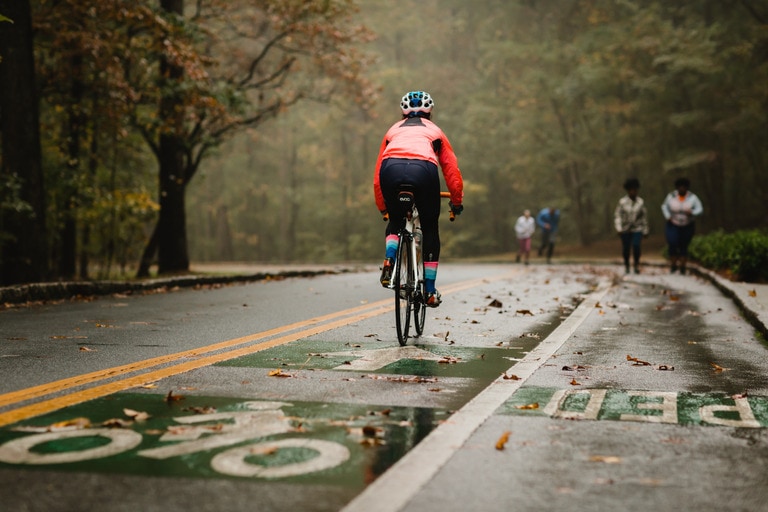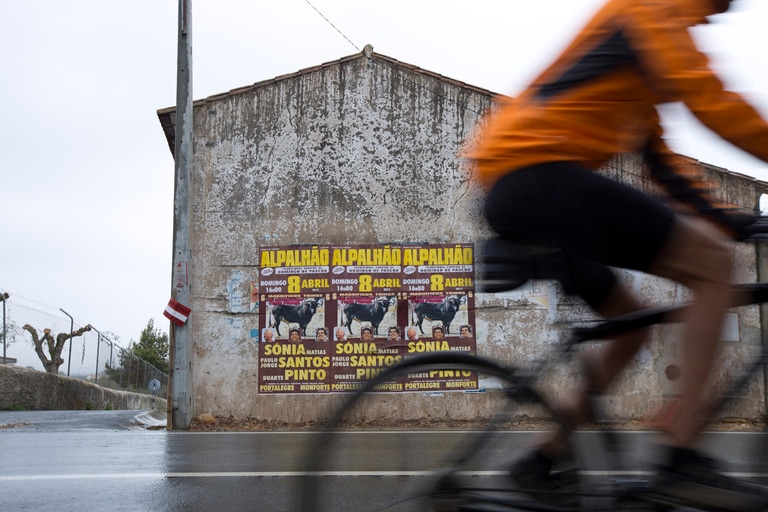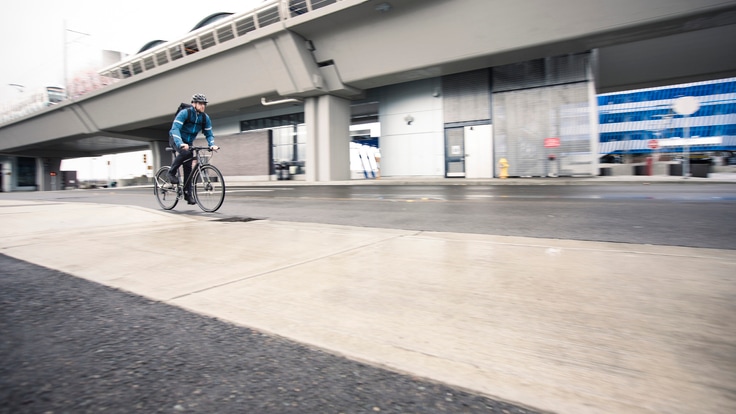Slick streets, dark skies, chilly drops pattering on pavement—when the rain begins to fall, it can be hard to get on your bike. Once you're out the door, though, cycling during the rainy season can be a rewarding way to commute, run errands or turn a weekend into an adventure.
"Bikes are this amazing multifaceted tool where you're getting exercise and getting where you need to go," says Reginald "Doc" Wilson, cyclist and founder of the nonprofit Peace Peloton. "Getting around on my bike helps me slow way down and appreciate what's around me. It just makes you feel good."
That freedom and pleasure almost always outweigh a little discomfort, says Martha Brown, a lifelong cyclist who has spent the last 16 years without a car in the Seattle area. Brown has done her share of commuting in adverse weather (including a 28-mile commute in sleet and snow) and even when it's tough to get out the door, the freedom of being on her bike always outweighs getting a little uncomfortable.
Whether you're considering commuting to work or just taking a weekend spin, here are tips for staying comfortable and dry during your next rainy ride. (For riding during cold months, learn tips on Cycling in Winter).
Dress for Warmth and Breathability

Spending time in the elements requires wearing layers of clothing. Brown recommends testing out different layers and clothing combinations over several rides to figure out your preference. In general, the longer your ride, the more venting you'll want. For long commutes in the rain, consider a light base layer, rain jacket, breathable cycling tights and waterproof cycling pants. (For our favorite staff picks, see our list of Best Cycling Jackets).
Add a headband under your helmet to keep your ears warm from cold airflow. If your commute is short and flat (think 15 minutes or less), you may not heat up to the point of needing a ton of venting. You can likely get away with a thicker sweater or base layer under your rain jacket. Look for jackets with pit zips for venting, which will help you increase airflow without having to take off your jacket.
Bike gloves: When cycling, fingers tend to get cold the quickest, especially when they encounter a breeze. Brown recommends wearing warm, waterproof gloves. Look for items made for skiing and kayaking and they'll cross over well.
Cycling shoes: Since most cycling shoes are designed to fit snugly, consider sizing up a half size in bike shoes so you can fit warm, wool socks underneath. Whether you prefer to ride clipless or on flat pedals is up to you, but it's nice to have solid traction on the soles of your shoes for stepping off your bike in traffic. Layer wind- and waterproof cycling shoe covers over your bike shoes to keep your feet dry and warm. On really cold days, Brown likes to layer foot warmers under her toes for an extra boost of warmth.
Pack Dry Clothes for Your Destination
If you're commuting to work, it's essential to arrive at your destination with clean, dry clothes. If you don't have somewhere at the office you can stash a change of clothes, Brown recommends waterproof panniers to carry them with you. "Make sure your bags are really waterproof," Brown says. "Rain has a way of sneaking into every little crevice, and you dont want to show up with your change of clothes soaked." You may not need a full outfit change for errands and riding around town, but always keep a dry pair of socks on hand or a pair of flip flops in the summer.
Get Your Bike Ready for Rain
Riding in cold, rainy conditions is hard on your components. Take a few extra steps to keep your bike clean and running smoothly.
Fenders: Front and rear fenders protect you and your bike from the elements. Tires kick up a ton of water and oil, and bike paths are often littered with dog poop. Fenders help keep that stuff off of you and out of your drivetrain, helping extend the life of the latter, says Brown.
Chain lube: When a wet ride is over, it's tempting to make a beeline for the shower. First, though, take a few moments to care for your bike, which will do wonders for the longevity of your components. Give the bike a quick rinse to remove all the grime and dirt. Then, wipe down the chain and reapply chain lube.
Ideally, you will have a sheltered location like a garage to store your bike. If you don't, cover your seat with a plastic bag so it will be dry when you return.
Tires: Tires are important. But you don't need the widest or knobbiest. Just use a set of thick, heavy-duty tires, and a fresh set for winter riding when it's slick, says Brown. Many brands make commuter-specific winter tires with a thick rubber compound that prevents flats, and reflective striping on the tire walls for visibility from the sides.
Bike lights: Staying visible is the cyclist's biggest safety concern when riding in the rain. Always ride with a front and rear light, and make sure your bags don't block them, says Brown. She also tells cyclists to choose reflective clothing and bags for added visibility.
Route and Riding Tactics
The road changes when it rains, and cyclists have to change how they ride, too. "The road surface will be the most dangerous just after rain begins to fall as the oils rise to the surface," Brown says. When possible, choose a gravel path instead of a road when it is pouring, Wilson says. Gravel drains well. There probably won't be many people on the path. And, bonus, you won't get splashed by cars.
Avoid sneaky obstacles: Watch out for maintenance hole covers, storm drains, painted surfaces and wet leaves, all of which are especially slick when wet. If you can't avoid them, try not to brake while atop them. When you can, avoid puddles; you don't know if there is a deep pothole lurking underneath that water.
Brake early: Start to brake earlier than you would in dry conditions. Why? "Most rims need one full revolution of the wheel with the brakes applied to squeegee the water off the braking surface and begin stopping," says Brown.
Ride in the right lane: It may seem counterintuitive to put yourself even more in the road, but riding in the right lane of traffic will encourage cars to give you more space than if you're way over on the shoulder. Wilson of Peace Peloton recommends sticking to the middle or right third of the outside lane, which helps you stay more visible to cars. This also prevents you from running into a parked car in the shoulder.
Stay Motivated

Perhaps the most challenging piece of riding in the rain is motivation. Why ride when you could hop in the car?
Doing this is a big change for a lot of people. So ease into it, our experts recommend. Start by going out for a short ride in bad weather. Or commute to work in the morning, then take the bus home.
Set yourself up for a good experience by doing some advance homework, too: Before heading out, check the forecast and map a route that gives you options in case the weather really takes a turn for the worse. "If it starts raining way too hard (yes, there's definitely a level of rain that I really don't enjoy riding in) and I'm halfway home, I know spots where I can jump on a light rail or bus," says Wilson. "Keeping those things in my head makes it easier to head out."
Adds Brown, "I'm not gonna lie, the first few times it's going to be uncomfortable before you dial in your equipment." And even for her, some days she's more in the mood to suit up than others. So cut yourself some slack if there are days, especially early on, where you look out the window and don't climb into the saddle, both cyclists say.
"If you start beating yourself up about riding it won't feel fun," Wilson says. The key is to get started. "Just try to build habits and stick with it."



